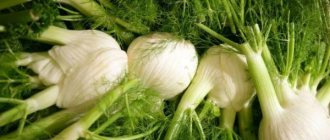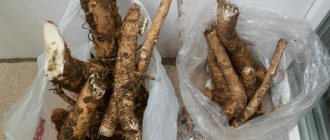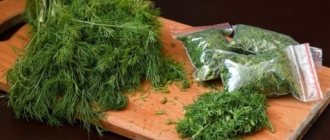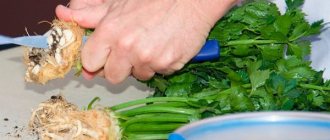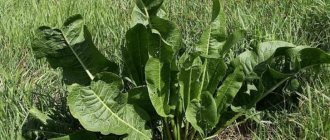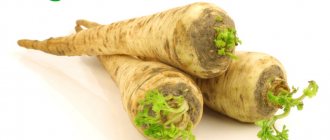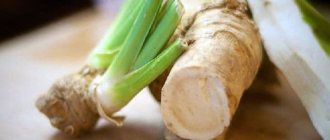Don't throw away the dill stems - they're a super addition to any dish.
Since autumn, housewives have been trying to preserve various fruits, vegetables and herbs for the winter. Dried sprigs of dill are often added to first and second courses to add flavor. But you can also use the stems of this spice. If cooked correctly, even branches that seem tough at first glance will be soft. When selecting the main ingredient, preference should be given not to dry and brittle trunks, but to soft and flexible ones.
Fragrant paste without sterilization
In the midst of the winter harvesting period, almost all recipes contain such a component as dill umbrellas. If you cut them carefully, you will be left with long stems. You don’t have to throw them away; it’s better to turn them into a fragrant paste.
Ingredients:
- dill stems - 2 large bunches;
- sunflower oil – 2 tbsp;
- garlic – 2-4 cloves;
- salt and acid (lemon juice) - to taste.
Preparation:
Wash the main ingredient under running water. Place on a paper towel and wait until dry. Pass through a meat grinder, add chopped garlic, vegetable oil, lemon juice or a little acid, and salt. Place the mixture in sterile jars and store in the refrigerator or basement.
How to collect correctly
An important ingredient in pickles, sauces, salads and fish dishes, fresh dill is available in markets throughout the summer and early fall. And if you dry it or cover it with salt, then throughout the year. In the food industry it is used as a seasoning. The cosmetic industry uses oil based on it, and the pharmacopoeia uses its medicinal properties.
We recommend reading: How to Store Boiled Red Beans
Harvesting the spice on an industrial scale is advisable when about 60% of the fruits ripen (in July). The plant is plucked or cut and tied into bundles for drying. Dry under canopies with natural ventilation. When the raw material dries, the seeds are collected and stored in paper bags. Freshly collected seeds are yellow-green in color, and as they dry they darken, acquiring a brown tint.
How to properly save seeds:
- To collect the seeds, you just need to wait until the plant blooms.
- Once most of the seeds in the umbel have formed, trim it and place it upside down in a paper bag.
- The seeds will gradually fall to the bottom of the bag.
- Then collect them in an airtight glass container.
A simple and quick way to prepare - drying
This method is the most common. Its popularity is due to the fact that it does not take much time to prepare and obtain a dry product. The dill stems must be collected, the umbrellas and young greens separated from them. Then chop as finely as possible and place on newspaper in direct sunlight.
The contents of the jars must be periodically checked and ventilated. This will help prevent the appearance of worms and food moths.
After complete drying, place the aromatic seasoning in containers. For ease of storage, it is better to use glass or plastic containers. It is recommended to keep the spice under a tightly closed lid so that moisture does not get into the dill and it does not spoil. In this form, the stems can also be used to prepare medicinal decoctions.
Pickling dill stems for the winter
The presented method of preparing aromatic spices for future use can be classified as classic options. In order not to spoil the product, it is important to strictly observe the proportions of both ingredients. Otherwise, the dill will turn out too salty and cannot be eaten.
Ingredients:
- young stems – 1 kg;
- table salt – 350 g.
Preparation:
Prepare the branches, wash and sort them. Set aside the thick stems so they don't spoil the flavor. Cut the greens into pieces of any size as desired. It is better to use glass jars with screw-on lids as containers. Sprinkle salt on the bottom, a layer thickness of no more than 5 mm, then dill, the top layer must be salt. At the end, close with a tight lid and store in the basement and refrigerator.
Freezing stems in molds
This method of preparation also cannot be ignored. It is convenient to use frozen dill in cubes and store compactly. In this case, the greens are immediately divided into portions, and there is no need to remove the entire bag from the chamber.
If desired, you can add your favorite spices and salt to the dill; instead of water, melted butter and broths are also used.
Pass thin dill stems through a meat grinder to obtain a homogeneous paste. Fill molds for ice or storing eggs with herbs 1/3 of the way and fill with boiled, cooled water. When the mass hardens, remove the mold and take out the ice cubes, then put them in a bag and store them in the freezer.
In winter, a piece of summer is often missing from prepared dishes. In order not to buy greenhouse greens in stores, it is better to harvest dill in the fall, when it is filled with vitamins and nutrients.
Beneficial features
To understand the benefits of certain plants, food industry institutes in different countries and pharmacists study their properties. The research results form an accurate picture of the beneficial properties of the plant. The uniqueness of dill is due to two types of healing components it contains: monoterpenes and flavonoids.
- Main beneficial properties:
- Monoterpene components protect the body from free radicals. And this allows us to consider the plant as a natural “chemical-protective” food that neutralizes carcinogens.
- Volatile oils (flavonoids) can prevent the development of bacteria, which provides the antibacterial properties of the spice.
- The plant is a good source of dietary fiber and minerals - manganese, iron and magnesium, which means it participates in the body's metabolic processes.
- Dill contains more than 150% of your daily dose of vitamin A, which is good for the eyes, and more than 100% of your daily dose of vitamin C, which is essential for supporting the immune system.
Dill also boasts significant amounts of folate, riboflavin, calcium, vitamin B6, potassium, and free radical scavenging antioxidants. All these components are certainly useful and necessary for the functioning of the body.
Keep it fresh
An ordinary household refrigerator is quite suitable for keeping bunches of any greenery in it for a short time.
If you are not going to store fresh dill for a long time, then:
- Take a bunch and put it in a jar. There is no need to wash the plants or trim the roots.
- Pour some clean water into the jar and cover the leaves with a plastic bag.
- Place the jar on the bottom shelf of the refrigerator.
In this case, the greens will not wither or turn yellow, but will remain juicy for 1-2 weeks.
You can store fresh dill in the kitchen for longer. If the garden is far away, then a piece of it can be transferred to the windowsill. Dig up young dill with roots, without destroying the earthen ball, and plant it in a flower pot. This will decorate the kitchen window sill and extend the time of use of the greenery. [flat_ab >
Some people try to grow dill from seeds on a windowsill. This is possible, but only in summer, and in winter you need powerful illumination with a phytolamp.
If you need dill throughout the winter, then use other options for storing it. Use:
Preparing for winter storage
Before choosing any of these storage methods, the plants must first be properly prepared:
- Rinse the greens purchased or collected from your plot under running water. Another option: place the stems in a deep bowl filled with water. Keep there for 10-15 minutes, and then rinse in the same way under a gentle stream of water.
- Then place dry towels on the kitchen table, spread the green stems on them in a thin layer, cover with paper napkins and let the moisture dry naturally.
Freezing – saving vitamins
It is best to freeze dill greens in the freezer. Here it can easily lie for 1 year without loss of quality and taste.
Entirely
Here's how to properly freeze dill for the winter:
- Place the dried stems, whole branches, in the freezer for 2 hours.
- Then remove and place in small portions in perforated polyethylene bags; alternatively, use cling film.
- Place the bags back into the freezer.
In winter, take out frozen dill and immediately use it for cooking.
Sliced
Here's another way to freeze dill in the refrigerator for the winter. The basis here is chopped greens. For preparation:
- Cut the washed and dried plants into small, 0.5-1 cm pieces.
- Place the mixture in bags or airtight containers in a thick layer.
- Place the preparations in the freezer.
In winter it is very convenient to get such semi-finished products and use them for their intended purpose.
Ice cubes
You can also store aromatic and healthy greens in the refrigerator for the winter in ice cubes, as in the picture below.
- Cut the dried stems into small pieces no more than 0.5 cm wide.
- Place in small portions into ice cube trays, filling them only 2/3 full.
- Fill the cutting containers with water to the brim.
- Place the molds in the freezer.
Remove the finished product from the refrigerator as needed and add to first courses as a seasoning.
During storage, do not subject the semi-finished product to repeated freezing and thawing. This will ruin the taste of the product.
How to preserve dill umbrellas. How to grow dill as a bush, or as an umbrella!
Dill comes in different varieties.
Some varieties quickly produce a few leaves and then begin to bloom. And umbrellas stick out in the garden on long bald stems, waiting for the cucumber harvest to go to pickling. But there are other varieties that take a long time to grow, but their leaves are lush and thick. And they are in no hurry to bloom. What to choose? For greens varieties: salute, buyan, alligator, dill, Amazon.
Sprigs of bush dill grow densely on the stem. In them, like tomatoes, additional fluffy shoots are formed in the axils of the leaves, and dill is obtained in the form of a bush.
These varieties are late ripening. In order for the plants to have time to ripen and produce seeds, they must be sown either in early spring as seedlings, or in a greenhouse, or in a film tunnel. Dill bush sometimes reaches a height of 1.5 m in open ground and 2.5 m in a greenhouse. And leaves of 35-45 cm may well seem gigantic. This dill provides greenery all summer long, and there is no need to sow it periodically. First, the leaves are plucked from the powerful basal rosette, then from the lower tier, and when the side shoots grow in the axils of the leaves, they are plucked out. And only then they remove the greens from the entire bush. It contains more vitamins a and c than the usual early ripening dill, and the yield is not 40-50 g per plant, but 150-200 g!
For a family of four, 20 bushes will be enough, which will provide greenery for the entire season. And the stems and late umbrellas will remain for canning.
Under bush dill, the soil should be nutritious. At 1 m? Add 0.5-1 bucket of compost. You can use mullein (1:10) diluted and fermented for 3-4 days or bird droppings (1:20). Neither dolomite flour nor lime is added to prevent the plants from turning red.
The seeds are sown dry to a depth of 1-1.5 cm, but they take a long time to germinate. To hurry, they are washed in hot water (50-55? C. growing scheme 20-25 x 25-30 cm. Only if the sowing is thickened, the dill will not bush.
After sowing, the seeds are covered with humus or soil, but not watered so as not to bury them, then the shoots will sprout well. Otherwise, light and small seeds may end up at different distances from the surface.
But after a few days the dill is watered. In general, it loves moisture and prefers sprinkling 1-2 times a week. During the season, the soil is loosened 4-5 times. Only if it grows poorly is fed with diluted biud (1: 20) or a complex fertilizer, for example mortar (1 tbsp. Spoon per bucket of water. Urea or sodium nitrate is not used so that the greens do not accumulate nitrates. Leaves are picked in the morning, when they are juicier.
For seeds. Varieties. Far, Gribovsky, umbrella, grenadier, dwarf.
The so-called umbrella dill is early ripening. It differs from the bush one in that it produces a peduncle much faster (after 30-35 days). It is used mainly in marinades and canned food. This dill has only 4-6 leaves. And if you sow only early-ripening varieties on the plot, there will be very little greenery, so the plants will have to be constantly reseeded, about once every 2-3 weeks.
Sometimes there is no time to collect the seeds of umbrella dill. They get enough sleep, get lost in the ground, and remain for the winter, hardening under the snow. They emerge the next year in early spring where they fell or where the flow of water carries them.
When you need to sow dill, do it not in one line, but in a wide furrow, as experienced gardeners advise. Take a board 5 cm wide and press it into the watered soil to a depth of 1-1.5 cm, and in this mini-trench the seeds are sprinkled in a zigzag. Furrows are placed every 10-12 cm. Then, when thinning, the plants do not fall over and wither. The final spacing between them is 8-12 cm.
Umbrella dill is rarely fed; usually it has enough nutrition in the soil. Only if it is initially poor, by 1 m? Add 0.5 tbsp. Spoons of superphosphate and potassium salt.
For both. Varieties. Lesnogorodsky, abundantly leafed, bushy, kibray, patterns, Borey, Richelieu, Umbrella, Max, herringbone, nikitos.
As a rule, mid-season dill varieties produce 10-12 leaves per plant. They are sown at intervals of 15-17 cm from each other on fertilized soil.
These varieties are universal, they are intended for both herbs and spices. After 40-50 days from germination, you can begin to pinch off the leaves, and after 65-70 days, the umbrellas with seeds are ready.
Tender leaves are plucked gradually, starting from the lower ones, one at a time. You cannot immediately expose the stem; leaves must remain, which will fully nourish the plant. Caring for “Srednyachka” is the same as for bush varieties.
Since bush dill is located relatively rarely in the garden bed, it can be severely suppressed by weeds. Especially at the beginning of life, because that’s when dill grows slowly. Therefore, such varieties have to be weeded often.
Dill varieties differ in the strength of smell, taste and amount of nutrients. More fragrant and vitamin-rich - bush ones. Umbrellas have their own advantage: already at the beginning - mid-summer they can be used as spices for preparing lightly salted cucumbers and marinades. Therefore, it is worth sowing at least two varieties of dill on the site.
Why does dill turn yellow? There may be several reasons: lack of nutrients, too dense sowing without thinning, dry soil. And with a lack of phosphorus, the leaves become reddish.
Salting - we prepare for future use
If you want to preserve dill for the winter at home longer, try pickling it:
- Dry the washed greens with napkins to remove excess moisture.
- Trim the roots and remove thick petioles, leaving only young green twigs.
- Finely chop the prepared greens.
- Sprinkle it with salt in a ratio of 2 parts dill to 1 part salt and place tightly in clean, sterile jars.
- Sprinkle a layer of salt on top.
- Close the containers tightly with a nylon lid.
- Keep jars in the refrigerator.
Pickled dill
Dill is an indispensable spice when housewives pickle cucumbers, tomatoes and mushrooms. But the greens that play a secondary role are worthy of becoming an independent dish. To pickle dill, only juicy greens without umbrellas and rough stems are selected. Plant materials are washed, placed in small jars and filled with hot marinade. After sterilization, the jars are closed and sent to a cool place for storage. The appetizer can be served with fried meat and game, mushrooms and other marinades. This preparation of dill for the winter will add piquancy to vinaigrette, pickle sauce, and bean and potato dishes.
Drying - easy and long lasting
Another proven recipe for preserving dill for the winter is to dry it. This method of harvesting greens for future use allows for the longest storage of the product, and at home you have several options to choose from. In addition, dried dill is convenient to use when preparing various dishes.
Naturally
So, plants can be dried with whole stems. For this:
- Carefully sort the greens, remove spoiled parts, cut off the roots.
- Rinse the branches under running water and dry them.
- Tie 10 to 15 stems together and hang them in a dark, cool, ventilated area.
- When they are dry, put the workpiece in boxes or fabric bags.
In the same way, you can dry the branches of a flowering plant along with umbrellas, and then add them to dishes as a seasoning in the winter months.
Dry chopped dill is a classic of the genre. It's very easy to prepare:
- Take fresh plants and cut off all the thick stems.
- Finely chop the remaining branches on a cutting board.
- Scatter the chopped herbs on the table, cover it with a towel.
- After 1-2 hours, spread the dill in a dry room on paper in a thin layer.
- Turn it over occasionally to ensure complete drying.
Collect dry dill and place in a container for further storage.
In the oven
Drying in the oven is another way to provide yourself with vitamins throughout the winter:
- Finely chop and place the dill in a thin layer on a baking sheet.
- Place the sheet in a warm (not higher than 50 °C) oven with the door ajar.
- During drying, stir the dill regularly so that it does not burn, but dries out on all sides.
- Let the workpiece cool.
Place it in prepared containers.
How to store dried dill
To ensure that the seasoning you prepare yourself remains aromatic and does not spoil, it is useful to know how to store dried dill.
- Glass jars with tight-fitting lids work best for this. This way, foreign odors, which are abundant in the kitchen, will not penetrate the product.
- Sunlight can cause the greens to fade, so keep the containers in a table or cabinet, behind a closed door.
You can preserve dill for the winter at home without any problems. Use each of the suggested methods to find out in practice what you like best.
Ways to use dill umbrellas
There are quite a few ways to use different parts of the plant. Leaves, seeds, and flowers are used in preparing fresh dishes, in winter preparations, and for other purposes.
First of all, it is worth noting its nutritional characteristics. The spice contains only 43 calories and can be used in dietary nutrition.
- What does dill help with and how to use the plant:
- Soothes the intestines and reduces bloating and flatulence. Its oils stimulate the secretion of bile and digestive juices, which allow the food eaten to be broken down into useful, easily digestible components.
- It also has antibiotic properties, which allows it to destroy foreign organisms and promote healing.
- A mild tea made from seeds and water helps relieve colic in babies and promotes restful sleep in children.
- Dill also promotes lactation in nursing mothers.
- A tablespoon of seeds contains as much calcium as one-third of a glass of milk. It helps protect the body from bone loss and is also an excellent source of calcium for vegans and people with dairy allergies.
- Its essential oils are quite unusual in that they are both stimulating and soothing.
Interesting: How to prepare walnuts for the winter
A cup of dill and chamomile tea will help you relax after a busy day at work.
The benefits of dill were written about in Egyptian medical treatises in 3000 BC. e. They noted its benefits in the fight against indigestion. For the same purpose, dill tea was used at the feasts of the Roman Caesars. The dried seeds were used by ancient soldiers to heal wounds. The psyche was treated with a mixture of dill, oil and honey. It was also considered a remedy for impotence.
In modern medicine, the plant is used to treat indigestion and hiccups. In Ethiopia, dill leaves are chewed along with fennel to treat headaches. Dill water will lose its properties after 24 hours, and its further use is no longer advisable - fermentation processes begin in it.
How to use dill, what to make from it and recommended dosages:
- Dill water is a boiled mixture of dill and fennel seeds. Half a teaspoon of this mixture at room temperature helps babies with indigestion and colic by relieving bloating.
- Tea made from the seeds is useful for people suffering from indigestion, diarrhea, menstrual pain, and bad breath. To prepare it, you need to soak 2 teaspoons of chopped dill in a cup of boiling water for 10 minutes. Tea made from 1 spoon of seeds is useful for nursing mothers to enhance lactation.
- Dill seeds can be chewed to freshen breath.
- The leaves contain small amounts of estrogen and may be beneficial for postmenopausal women. The juice from the fresh plant is beneficial to the urinary system. It also has antifungal and antibacterial properties. Use 30–50 g per day.
- Dill oil is obtained from seeds industrially. It can be added to food to enhance its benefits. Creams and ointments based on it can help heal wounds.
In cooking
Dill is used in most soups and fish dishes in many countries around the world, including Russia, Sweden, Thailand, Laos, Hungary and Vietnam. This is the main product for pickling pickled cucumbers, as well as delicious herbal bread.
It is added to gravies, sauces and salads to increase the beneficial qualities of the dish. Cookbooks from all countries contain many recipes that include dill. But among them there are also methods of application that are common to all.
What can be made from dill:
- combine greens with low-fat yogurt or sour cream and add fresh cucumbers. It will be a great addition to your dinner;
- Use it when cooking fish, especially salmon and trout. The aroma of fish and spices complement each other perfectly;
- decorate sandwiches with it;
- place the seeds on the dinner table with other spices so that family members can add them to their dishes;
- When preparing mashed potatoes, add their seeds along with the herbs.
